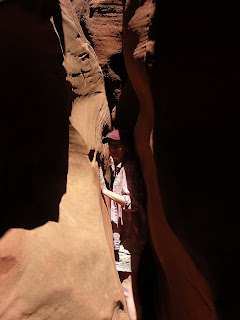 Dry Fork Wash along the Hole-in-the-Rock Road
Dry Fork Wash along the Hole-in-the-Rock Road
Grand Staircase-Escalante National Monument outside Escalante, UT
It's time to start posting some of my images and experiences from southern Utah. My wife and I spent eight days from May 15-23 exploring Grand Staircase-Escalante National Monument and Capitol Reef National Park in south-central Utah. Our first day hike took us to the slot canyons of the Dry Fork Wash located southeast of Escalante, UT along the Hole-in-the-Rock Road.
Slot canyons are narrow defiles just barely wide enough to squeeze through--a slot in the canyon wall. They typify the West as portrayed in Sierra Club and Audubon calendars, with their sinuous, sensuous curves carved by thousands of years of flood-borne sand and strikingly elegant lighting.
We left our 4WD SUV parked at the rim of the Dry Fork Wash and descended over a slickrock trail marked with cairns to the bottom of the wash. The first of the slot canyons was apparent on the opposite wall of the wash when we reached the bottom: Peek-a-Boo Canyon. Unfortunately, there is a very slippery pour-off right at the mouth of Peek-a-Boo, and, try as I might, I just couldn't get up over the pour-off into the canyon proper. I finally gave up. (I later learned that no one can get over the pour-off alone; it's necessary for someone to come into the canyon from above, and then, using a rope, pull one's companion up over the pour-off into the canyon, but no one told me that ahead of time.)
So, we walked a short distance downstream to the second slot canyon: Spooky. The mouth of Spooky Canyon is level with the floor of the Dry Fork Wash, so we could just walk inside.
 The mouth of Spooky Slot Canyon
The mouth of Spooky Slot CanyonAt first, the canyon isn't intimidatingly narrow. Near the entrance, we encountered these three good friends posing for a photograph who were exploring the slot canyons and seemed to have Velcro on their feet.
 But, further into the canyon, the walls close in...
But, further into the canyon, the walls close in... ...until it's only possible for slim folks to get through turned sideways.
...until it's only possible for slim folks to get through turned sideways. My impressions of the narrowest parts of Spooky Canyon follow.
My impressions of the narrowest parts of Spooky Canyon follow. 
 The red rock evoked for me the torso of a pregnant woman.
The red rock evoked for me the torso of a pregnant woman.
Though it's possible to climb up and out of the far end of Spooky Canyon, hike overland for about a quarter mile, and then descend into Peek-a-Boo Canyon, we decided instead to retrace our steps and leave Spooky the way we entered. Once we were back in Dry Fork Wash, we hiked upstream to the point where Dry Fork Wash emerges from its own beautiful and very narrow canyon--maybe not a slot, technically, but very narrow nonetheless. Don't get stuck here in a desert downpour!
 In Dry Fork Canyon
In Dry Fork Canyon  Returning to the car from the bottom of Dry Fork Wash over slickrock
Returning to the car from the bottom of Dry Fork Wash over slickrock
 Birding in The Wash
Birding in The Wash A huge cottonwood tree growing on a slope above the riparian zone
A huge cottonwood tree growing on a slope above the riparian zone




















































